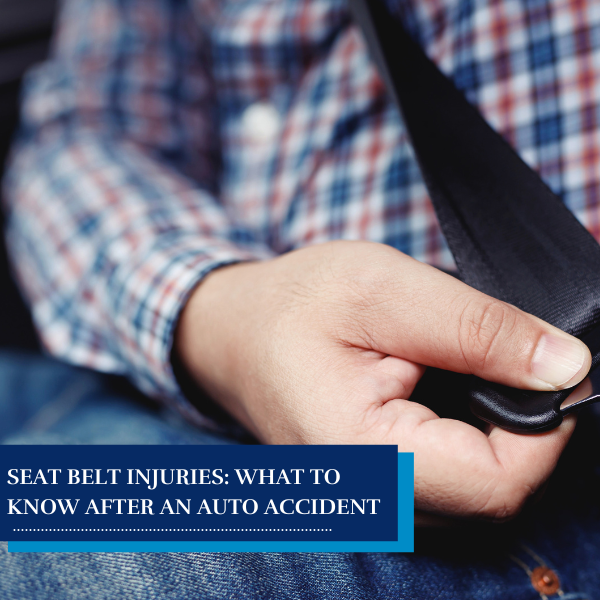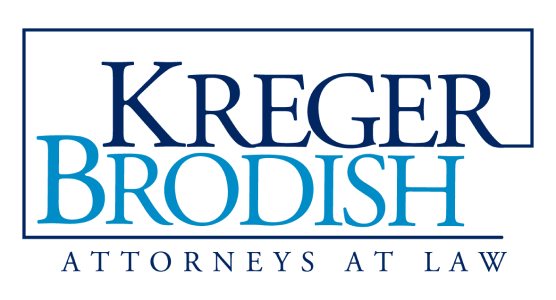
Seat belts are supposed to prevent car accident injuries. What should you do if a seat belt injures you?
If you’ve sustained seat belt-related injuries in an auto accident, you may have the right to seek financial compensation for your recovery expenses. Contact Kreger Brodish LLP for a free initial consultation with a car accident lawyer to discuss your legal options.
Why Do Seat Belt Injuries Happen?
Seat belt injuries may occur in car accidents for several reasons. Common causes of seat belt injuries include:
- Not Wearing the Seat Belt in the Correct Position—An improperly worn seat belt is more likely to injure a passenger in an accident.
- Children Not Using Booster Seats—Booster seats ensure that seat belts lay correctly across a younger child’s body. Children should continue to sit in booster seats until they can sit in the regular seat with the belt in the correct position across their body.
- Inadequate Seat Belts—Seat belts that only have the lap belt portion, instead of a three-point seat belt with lap and shoulder belts, are more likely to inflict injuries in a car crash.
- Damaged Seat Belts—Damage to the seat belt or the tensioner can increase the chances of a vehicle occupant suffering seat belt injuries in an auto accident.
- Manufacturing Defects—Manufacturing defects can cause seat belts to perform incorrectly in motor vehicle crashes.
The Spectrum of Seat Belt Injuries
Although seat belts save lives, they can also inflict injuries in motor vehicle accidents. Some of the most common seat belt injuries include:
- Abrasions—Seat belts can cause skin abrasions across the lower abdomen or diagonally across the neck and chest. Abrasions or bruising underneath the seat belt may also indicate internal injuries in the chest or abdomen.
- Fractures—The force of a collision can cause seat belts to break the sternum, clavicle, or ribs. Broken chest bones can also damage the lungs or heart. Seat belts that only have a lap belt without a chest strap can also cause fractured vertebrae in a collision.
- Soft Tissue Injuries—Seat belts can strain, sprain, or tear soft tissues, including ligaments, tendons, muscles, or spinal discs. Lap belts can also cause tears in the abdominal wall or damage to abdominal organs, especially when vehicle occupants wear the lap belt across their abdomen rather than their lap.
- Vascular Injuries—Forces in a motor vehicle crash can cause seat belts to tear or rupture blood vessels, including major vessels like the aorta, which can cause potentially life-threatening internal bleeding.
Preventative Measures and Safety Tips
Drivers and passengers can reduce their risk of suffering seat belt injuries, as well as prevent injuries from being more severe, by following these safety measures:
- Always wear seat belts in the correct position. The lap belt should lay across your hips, beneath your stomach. The shoulder belt should cross your chest and not lie near your neck.
- Ensure that the seat belt feels snug but comfortable. Wearing a loose or tight seat belt can increase your chances of suffering abdominal injuries.
- Pregnant women should wear the lap belt under the belly and over the hips and the shoulder belt between the breasts and to the side of the belly.
- Young children should sit in booster seats that place the seat belt in the correct position.
What to Do After a Seat Belt Injury
When you’ve suffered seat belt injuries in an auto accident, taking prompt action can help you when pursuing financial recovery. Take these steps after sustaining a seat belt injury:
- Report the crash to law enforcement and request a copy of the police crash report.
- Seek prompt medical attention to identify any seat belt injuries you may have sustained in the crash.
- Follow your doctor’s treatment or recovery instructions.
- Obtain medical records of treatment and rehabilitation you received for your injuries.
- Keep any bills, invoices, or receipts for recovery expenses you incur.
- Gather your pay stubs if you need to miss time from work while recovering from your injuries.
Finally, contact a car accident attorney from Kreger Brodish LLP right away to discuss the next steps you can take to seek compensation for your seat belt injuries.
Who Is Liable for a Seat Belt Injury?
Various parties may bear liability for your seat belt injuries, depending on their cause. When seat belt injuries occur in a car crash, you may have a claim against the driver at fault for causing the accident. If injuries occur due to a malfunctioning seat belt, you might have a claim against auto mechanics who failed to repair the seat belt system. However, if you sustain seat belt injuries due to a defective seat belt, you may have a product liability claim against your vehicle’s manufacturer.
Statute of Limitations to File a Claim
Under North Carolina’s statute of limitations on injury claims, you typically have three years after suffering seat belt injuries in a car crash to file a lawsuit against those at fault for your injuries. However, you can protect your right to seek compensation by contacting the auto accident law firm of Kreger Brodish LLP as soon as possible after an auto accident to ensure your injury claims get filed on time. If you file your claims after the applicable limitations periods expire, you may lose the opportunity to seek financial recovery for your seat belt injuries.
Contact Our North Carolina Car Accident Attorneys to Learn More
After suffering a seat belt injury in a motor vehicle accident, get the legal representation you need to pursue financial recovery and move forward with your life. Contact Kreger Brodish LLP today to learn more about your legal rights and options in a free consultation with an experienced car accident attorney.






